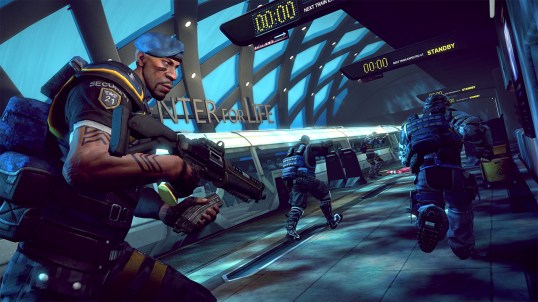There’s a lot of moaning about how so little though goes into the story and scenarios of most video games and the first-person shooter genre, especially, catches a lot of that criticism. Some of that grousing is justified, with all the grim, square-jawed super-soldiers and cookie-cutter corridor combat that gets churned out year after year.
But, much as they’ve done with the game design and ideas going into Brink, the team at Splash Damage is trying to make a gameworld that looks and feels different that much of what’s out there. In the interviews that follows, lead writer Ed Stern describes how he and the other developers working on Brink have tried to infuse the plot with character and the environment with a narrative all its own.
Brink hits Xbox 360, Ps3 and PC on May 17th for North America and on May 20th for Europe.
Ed, the story in Brink seems to be designed in a modular way, where you could almost play it out of order. Is that the case and, if so, is that intentional?
Absolutely, yes. One of the challenges with writing Brink’s Security and Resistance campaign storylines was that, while we assumed most players would pick a faction and then play that campaign’s missions in order, we didn’t want to prevent friends from playing with each other. That meant they had to be able to join each other’s campaigns to make their single player game instantly co-op or multiplayer at any point, so each mission and cinematic had to make sense on their own, in any order.
Also, with Brink, there’s genuine replay value in the maps and the cinematics. Even if you’ve played a mission before, there may be minor details in the cinematic you missed that only become significant once you’ve played through both campaigns or listened to an audio diary. Alternatively, you can just skip them and get on with running around and shooting stuff. That’s a completely valid way to play the game too.
(More on TIME.com: On the Brink: Hands-On with 2011’s Experimental Shooter)
There seems to be a lot of sociological commentary churning in the game’s environment and story. Where did you go for inspiration for that?
We want Brink to be sticky: both to draw players in and keep them imaginatively engaged, even when they’re not playing. The test of any character or scenario is whether it lives on in your imagination even after you’ve stopped playing the game, so we wanted to incorporate real world thematic content into the storylines for Brink for players to become engaged.
The Ark is a microcosm, where any and all real-world tensions and issues exist, in exaggerated crucial form. It’s a place where stories can happen, where people from all over the world are crammed onto a floating city with limited resources and extremes of material inequality. You don’t have to go far to find true tales of economic, political, moral, psychological or dramatic conflict. It’s all out there, and some variations of it went into Brink. Players are much more likely to have some sort of opinion about real-world issues than invented ones. No, wait, what’s the ratio of Wikipedia entries about Star Trek: The Next Generation to World War II? Forget I said that.


